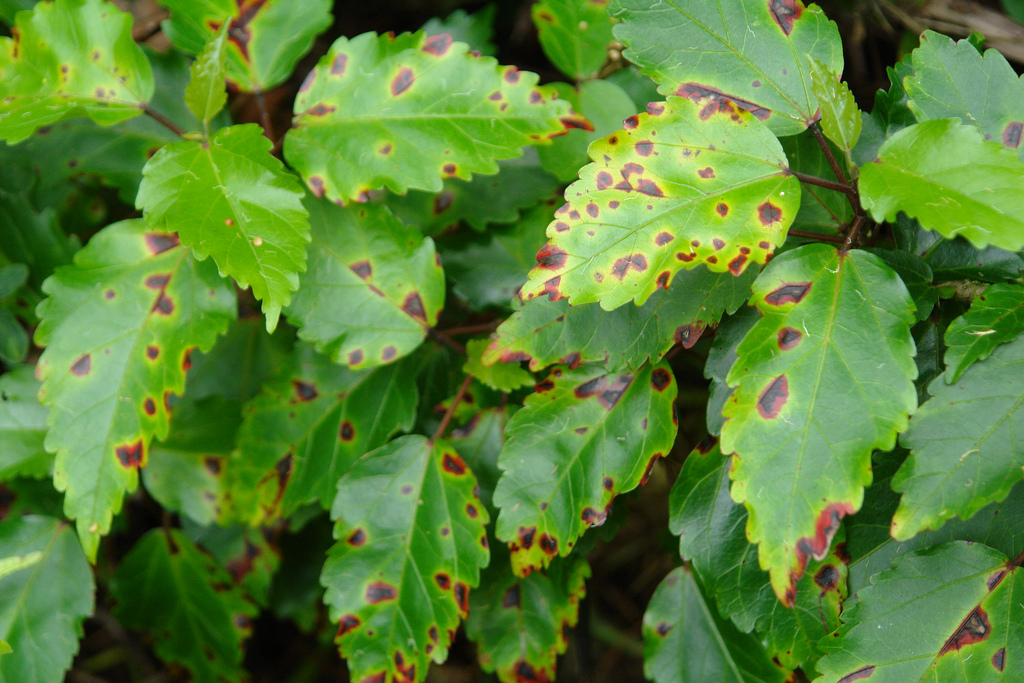Introduction
Bacterial leaf spot is a disease that affects various crops and ornamental plants. It is most often caused by the bacterial pathogens Pseudomonas spp. and Xanthomonas spp. The infectious pathogens dwell on the foliage of susceptible plants. They invade plants through leaf and bark wounds, as well as through openings that have been created due to pruning. Infected plants will develop leaf spots, which discolor and kill leaves. The disease is most prevalent on older leaves, but when conditions are favorable, it can also infect new growth. Bacterial leaf spot is highly contagious. Warm, moist conditions can cause clusters of vulnerable plants to be readily infected within a few hours.
Distribution & Habitat
Bacterial leaf spot occurs globally, wherever susceptible plants are present. It is widespread throughout Asia, Europe, and North America.
Hosts
Bacterial leaf spot infects a multitude of crops and ornamental plants. The most frequently infected crops include beets, eggplant, kale, lettuce, peppers, and tomatoes. Ornamental plants that are commonly infected include begonia, dumb cane, English ivy, ficus, geranium, hydrangea, laceleaf, philodendron, poinsettia, syngonium, and plants in the genus Prunus.
Disease Cycle
In early spring, moist, cool conditions encourage bacterial pathogens to form. The bacteria are subsequently disseminated to susceptible plant foliage by rainfall, irrigation, insects, and air currents. They may also be inadvertantly transported to new areas on infected seed. In sites that have previously been infected, the bacteria may overwinter on plant debris, or in soil.
Once the bacteria become established on a plant, they rapidly multiply. Temperatures between 77º F and 86º F increase the rate of multiplication. High rates of infection will result in extensive leaf loss, which can compromise a plant’s vitality. As temperatures cool from late fall to winter, the bacteria may overwinter in diseased plant material. The bacteria will resume activity the following spring, when temperatures increase.
Symptoms of Infection
Symptoms of infection generally appear within 3 to 7 days. Infected plants will develop lesions, or spots, on their foliage. Lesions may form on the top or bottom portion of a leaf. The lesions are initially small, but can develop an angular shape once the infection has reached the leaf veins. As the infection advances, the lesions will gradually enlargen, growing between 3/16 and ½ of an inch in width. In some instances, a chlorotic halo may form around the spot. Several spots may coalesce, causing infected leaves to die. Some leaves will dry up in the center, and crumble away. This will cause them to assume a “shot-hole” appearance.
Infected shoots, buds, and flowers may blacken, and wither. Infected flowers will become desiccated, and break off easily. V-shaped necrotic areas may form on the leaves of begonia and geranium. On begonia, water-soaked lesions will become visible on the underside of diseased foliage. When infected, hydrangea leaves will turn a reddish-purple. Flowering plants will often wilt.
Management
- Avoid planting in diseased locations for at least a year.
- There are currently no recognized chemical treatments for bacterial leaf spot.
- Registered fungicides may be applied in early spring to control the disease.
- On ornamental plants, remove the affected leaves once infection symptoms become apparent. This will prevent the bacteria from spreading to healthy leaves and plants.
- Rake and dispose of fallen leaves to eliminate potential sources of bacteria.
- When planting, avoid overcrowding trees and shrubs.
- Remove plant debris from gardens to reduce the potential for overwintering bacteria.
- Prune trees and shrubs periodically to increase light penetration, and improve air circulation throughout the crown.
- Avoid mechanical injuries to susceptible plants.
- Adjust irrigation to prevent vulnerable foliage from being doused with water.
- Maintain plant vigor through sound cultural practices. Ensure that plants are sufficiently watered, especially during extended periods of drought.
- Apply a layer of organic mulch around the base of plants to improve soil quality, moderate soil temperature, and retain soil moisture.
- Avoid fertilizing plants that are suffering from bacterial leaf spot.
Photo courtesy of Bacterial Leaf Spot: Scot Nelson CC-by-SA 2.0


